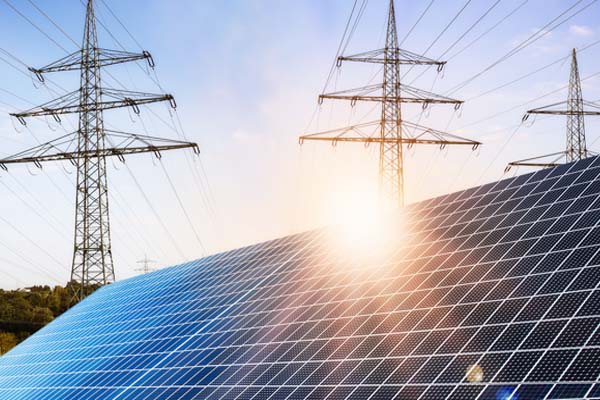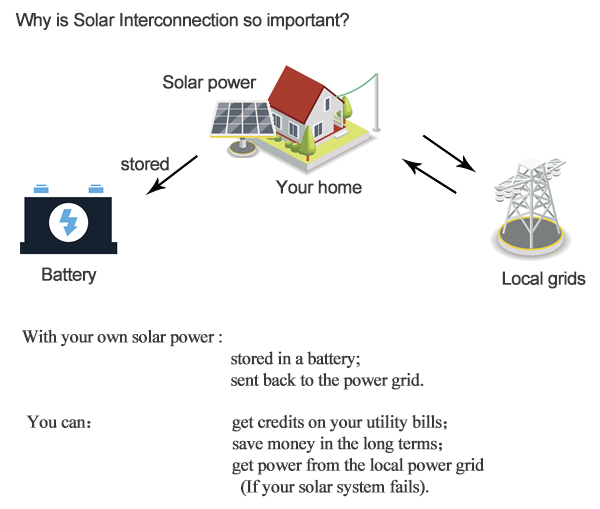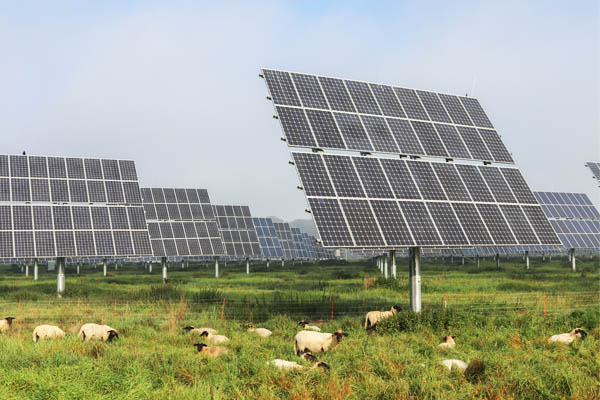Solar Interconnection: Process & Purpose
When you decide to install solar panels, you can choose between going completely off-grid or staying connected to the power grid in your area. Both of these decisions have pros and cons, but most commonly, people choose to stay connected to a power grid after installing solar. By staying connected, you can access energy during bad weather or when you consume more than you have stored in your solar systems.
Choosing to stay connected to the local or state power grid despite having a solar energy system is called solar interconnection. The Solar interconnection process is usually conducted by the installation company, the customer (you), and the utility company that serves your area. Because solar power has become much more commonplace than it was 20 years ago, there’s a fairly uniform solar interconnection process across most of the US. At a high level, many of the requirements will be taken care of by your installation team, but even so, it’s important to understand solar panel interconnection.
Table of contents:
- What is Solar Interconnection?
- The Importance of Solar Interconnection
- The Solar Interconnection Process
- How Does a Solar Interconnection Agreement Work?
- What are the Requirements for Approval of a Solar Interconnection Agreement?
- How Much Does Solar Interconnection Cost?
- How to Interconnect Solar Panels?
- How Long Does Solar Interconnection Take?
- Get Started Today
What is Solar Interconnection?
Interconnection refers to the linking or the interconnecting of a user's distributed generation facilities into the grid. Once a customer’s electricity generating facility is connected to the grid, the customer can receive credits for excess electricity they generate. This is a billing arrangement, which is often called net metering.

The Importance of Solar Interconnection
Solar panel interconnection is the tried-and-true method for ensuring that new energy sources, such as your solar panel system, can effectively and safely communicate with the power grid in your area. Power grids were initially designed to push power out from a central location to many residential and commercial buildings, but with the rise in solar usage, grids now have to be able to take power in from residential and commercial sources.
Solar panel interconnection offers many benefits to the households that enter into the interconnection agreement. Solar power can be stored in a battery at your home, but when you have excess, instead of letting it go to waste, it can be sent back to the power grid and used by other homes in your area. If you live in an area that participates in net metering, you can actually get credits on your utility bills for solar panel interconnection.

Staying interconnected to the power grid also ensures that you are never without electricity when you need it. If your solar system fails, the local power grid can offer an alternative source of electricity, keeping you safe in danger, such as major storms.
On the utility side of the equation, solar interconnection agreements are critical in keeping the entire power grid safe and operating effectively. Inspection is Part of the agreement process to verify that your equipment is compatible with your power grid. For instance, when the power goes out in your area, interconnected systems will stop sending power back to the grid, keeping repair workers safe while they are doing their best to bring power back to the community.
The Solar Interconnection Process
The Solar interconnection process consists of three parts: applying for interconnection, installing the actual solar system, and obtaining permission to operate. This is a collaborative process between your utility company and the solar installation company, but you’ll also need to sign agreements and understand what’s happening. Let’s go through it step-by-step:
Pre-Installation: Applying for Interconnection
To stay connected to the power grid, you need to apply for interconnection before installing your solar panels. Your solar company will need to submit an application to the utility company on your behalf. The application will inform the utility company of the electrical plans, equipment details, and the design of your system. The purpose of the application is to give the utility company a chance to review the details of your installation and ensure it meets the compatibility requirements with the power grid.
The utility company can request additional information or send the application back at any point during the review process. They may detail additional requirements you need to meet or outline equipment that needs to be changed. Don’t be alarmed if the application process takes an attempt or two before you secure approval for interconnection.
Installation
Once your solar company gets the green light to move forward with the installation, they can begin their work. This part is done independently of the utility company, but in step three, there will be an inspection to check the system.
Post-Installation: Permission to Operate
After the solar company finishes installing your new solar system, and before you start using it, you will be granted permission to operate by the utility company in your area. Essentially, it is a second part of the above application that gets completed by the installation company and shared with your utility provider.
This portion includes photos of the installation, finished paperwork, and any other supporting documents that might need to be determined that your system is safe to be interconnected with the power grid. Your utility company will also send an inspector to verify that everything was set up properly. That inspector will also change or adjust your meter to be a bi-directional one so the amount of kilowatt-hours you use and produce can be measured with ease.
It's possible that the inspection could showcase a shortcoming or highlight an unmet requirement; in that case, your installation team will need to rectify the situation and reapply for permission to operate. After the approval is complete and you have PTO, you can use your system to generate electricity!
How Does a Solar Interconnection Agreement Work?
The solar interconnection agreement is a contract between a household or customer and the utility company. It outlines all the rules and regulations regarding how your solar system and the power grid will work together. Here is where you’ll find information about net metering (if available) and safety regulations.
This document is part of the solar interconnection process and must be submitted to the utility company before installing a solar system. Keep in mind that this agreement is legally binding, so be sure to read the fine print.
What are the Requirements for Approval of a Solar Interconnection Agreement?
A governing body outlines and maintains the requirements of solar interconnection agreements on a national level. The Interstate Renewable Energy Council (IREC) helps guide households, solar installation companies, and utility companies on what to look for within solar connection agreements to keep the power grid safe for customers and providers.
How Much Does Solar Interconnection Cost?
The cost of solar interconnection for residential customers is very minimal. It shouldn’t be more than a couple of hundred dollars to complete the process, and often, installation companies absorb this cost into the installation process. The main “cost” of this process is time, so be sure to factor that in when you’re making a solar installation plan. Again, your installation company should help you through this and factor it in when needed, but it’s helpful to know prior to starting the process.
Commercial solar interconnection is more complex, costly, and time-consuming. Most power grids today are well-outfitted to manage the inflow and outflow of energy from residential sources, but commercial solar systems produce more kilowatt-hours by far. To accommodate commercial solar interconnection, utility companies may need to update the power grid’s capabilities, requiring costly infrastructure and equipment investments.

How to Interconnect Solar Panels?
The actual solar interconnection infrastructure will be taken on by the solar installation company that you work with. They will ensure that the right equipment is in place and follow the requirements of interconnection throughout the process.
As stated above, the energy company will need to equip your property with a bi-directional meter to measure your input and output, as well as enable you to give power back to the grid. These steps won’t require anything from your side besides signatures and oversight. If you are looking for wonderful solar panels, we highly recommend Renogy’s 320 Watt Solar Panel, 450 Watt Solar Panel, and 550 Watt Solar Panel for your home.
How Long Does Solar Interconnection Take?
The amount of time that will be needed to complete solar interconnection will vary based on the size of your solar panel system and the utility company that you’re working with. The process for applying and getting permission to operate requires the utility company to keep the process moving, and when hang-ups happen, it’s usually within these steps.
To keep the process moving along swiftly, be sure to respond to any requests or inquiries in a timely manner. Usually, in an average situation, solar interconnection will take 4-6 weeks. Try to budget a 2-3 week period for the initial application process, another week or two for installation, and then another two weeks for the inspection and obtaining permission to operate.
Get Started Today
Working with the right solar installation company can make the solar interconnection process a breeze. Since many customers want to install solar without going off-grid entirely, this is a common methodology. If you want to know more about the solar systems and installation(for example, How to Find the Best Solar Installation Contractors?), please move to our blog and feel free to contact us!
Although solar interconnection sounds complex, most areas have a robust system in place, and utility companies are well-acquainted with installation companies in their areas. We are all working together to advance the impact of solar power.
Related articles:
Building a highly efficient solar installation
Tips for a safe solar installation
Is A Hybrid Solar System Right For You? Let’s Find Out








